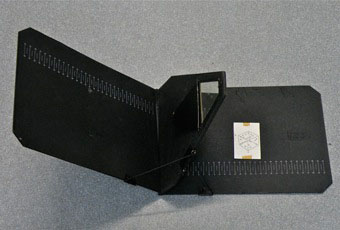Pigeon-Cantonnet stereoscope
Catalogue Number: 2827 Pigeon-Cantonnet stereoscope Category: Equipment Sub-Category: Synoptophore, stereoscope Designer/inventor: PIGEON Leon, CANTONNET Andre Louis Henri Year Of Publication/Manufacture: c 1950 Time Period: 1940 to 1999 Place Of Publication/Manufacture: England Publisher/Manufacturer: E. O. Co Description Of Item: This is a stereoscope for clinical ophthalmic investigation and treatment of strabismus and other disorders of binocular vision, originally devised c 1904. It consists of three black card boards, 230 x 320 mm, attached together as in a book, with a plane mirror fixed on one face of the middle leaf and targets can be placed and moved around on the inside of the other two leaves. The inside surface of each of the outer boards has a numeric linear scale. The central leaf acts as a septum and one eye sees one target directly while the other eye sees the other by reflection in the mirror. The angle of convergence may be controlled by the angle between the leaves, which can be adjusted to one of two positions by a cord attached to the edges of the outer leaves with a metal loop in the middle of the cord to attach it to one of two positions on the middle leaf. A plane mirror is fixed on one side of the middle board and has a truncated triangular shape with a hinged metal flap and a clip to cover the mirror when the instrument is not in use. The outside of one outer flap is marked THE PIGEON-CANTONNET / STEREOSCOPE / MADE IN ENGLAND / E. O. Co. There is one of a pair of stereocards with the instrument. Historical Significance: Leon Pigeon (a professor at the University of Dijon, France), devised this instrument for viewing stereoscopic photographs and applied for a patent on November 16th, 1904, to protect his invention. Unlike Wheatstone's mirror-stereoscope, which used two mirrors, Pigeon's invention only needs one mirror. And therefore, only one of the images forming a stereo-pair (the one viewed through the mirror) has to be printed reversed or "mirror-inverted". A Dr Monnet investigated its use for the treatment of squint (Strabismus). Dr Cantonnet made modifications to it so it became known as the Pigeon-Cantonnet stereoscope. Its use in clinical practice is described on pages 67 to 71 in the book 'Strabismus: Its re-education: the physiology and pathology of binocular vision' by CANTONNET Andre Louis Henri, FILLOZAT Jean with the collaboration of G. Fombeure. Translated by Max COQUE 1934, See Cat No. 154. Cantonnet was an ophthalmologist at the Larenec Hospital in Paris and Director of the Albert Remy School of Re-education. How Acquired: Donated by Estate of William Cooper, via Peter Lewis Date Acquired: Mar 2016 Condition: Fair Location: Archive room. West wall. Unit 3 Drawer 2 |


